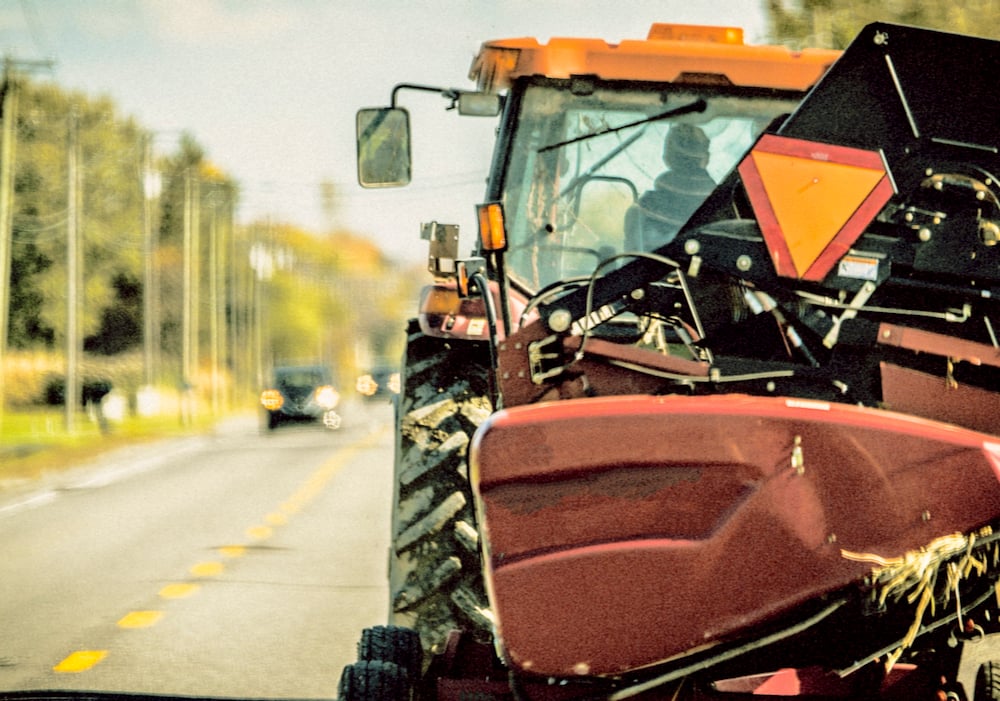What’s legal and what’s not for farm equipment on the road

Farm equipment and farm operators are exempt from many of Ontario’s highway transportation regulations, but these exemptions are far from uniform.
Read Also

Global demand for pork remains strong, buoying industry optimism
Ontario Pork’s chairman delivered a sombre but optimistic assessment of the industry’s future during the organization’s annual general meeting in…
During an Ontario Agricultural Conference session, transportation ministry enforcement officers Yvette Campeau and Matthew Mitchell reminded attendees that such exemptions rely on a number of qualifiers.
Why it matters: Safely moving farm implements and machinery is increasingly important as more drivers make use of Ontario’s rural roads.
Further, they said Ontario farmers must not forget the basics because proper signage, lighting and other requirements are critical to accident prevention.
What qualifies for farm exemptions?
Regulation exemptions for farm vehicles apply when those vehicles are in operation on Ontario highways, which means any public road in the province.
To qualify as a farm vehicle on these roads, vehicles must be a “self-propelled instrument of husbandry,” otherwise known as something that was “manufactured, designed, redesigned, converted, or reconstructed for a specific use in farming.”
A dump truck does not count unless, for example, the box has been removed to accommodate a manure applicator. Once no longer of practical use for other purposes, the truck may now qualify for farm transport exemptions.
Trailers can also qualify for exemptions, although there is more complexity.
Weight is used to determine Ontario’s transportation safety regulations, including licence level and requirement for weight inspection.
For farm vehicles and trailers, 4,500 kilograms is the weight at which commercial vehicle registration is required. Campeau says exemptions can apply above the 4,500-kg line, but they are far fewer.
Pickup trucks can be exempt from requiring commercial registration if they are not for personal use, or not hauling cargo for another commercial purpose. Using the truck to move equipment via a trailer would not garner an exemption.
There are also weight restrictions for pickup trucks, as well as limits on modifications to the box. Replacing a truck bed with another identical bed is fine, but installing a larger bed with equipment storage capacity is not.
Weight limits for each licencing level are as follows:
G: The lowest tier covers vehicles up to 11,000 kg and trailers up to 4,600 kg. Mitchell says weight is calculated by combining both vehicle and trailer weights. “If you have a pickup truck pulling a trailer and we stop you, and weigh both the truck and trailer, and that combined weight is greater than 11,000 kilograms, then you have the wrong class licence.”
D: This applies to cars and trucks over 11,000 kg, and trailers under 4,600 kg. D class licences are deemed G if the vehicle is farm plated, owned or leased by a farmer, used for personal transportation or movement of farm products, supplies, and so forth, and without compensation. Moving a product for someone else in exchange for payment (compensation) removes the exemption.
A: This licencing level applies to trucks of any weight and trailers over 4,600 kg. AR (A Restricted) is a sub-class, giving an operator the ability to operate a truck pulling two or three axel trailers. Mitchell says this is a useful licence in farming, after reiterating AR licences do not allow operators to drive airbrake equipped vehicles such as transport trucks.
Inspections and hours of operation
Regarding inspections, Mitchell and Campeau say watching for major and minor defects (a burnt-out rear brake light is an example of the former, and a faulty front turn signal is an example of the latter) is important for anyone required to do daily vehicle inspections.
The “Schedule 1” resource, available from Ontario’s Ministry of Transportation, details what constitutes major and minor defects.
Farming exemptions to daily vehicle inspections apply for “a two or three axle trailer, bus, or tractor, not drawing a trailer, which is primarily used to transport primary products from a farm, forest, sea or lake, produced or harvested by the driver or the driver’s employer.”
But farm equipment operators are not necessarily exempt from penalties if, upon inspection by transportation officers, defects are found.
“We are going to exempt you from doing [daily inspections] but we’re not going to exempt you if we find a defect, if you guys can read between the lines. I always say its worth doing a 20-minute trip inspection. You know it’s safe. You don’t want to be in that position,” says Mitchell.
On hours of operation, he said farm operators are “completely exempt” as long as the definition for farm vehicles and farm operations is met, but he encourages farmers to be cognisant of fatigue.
Both officers say some farm operators have encountered trouble when it comes to annual inspections for vehicles and trailers. All based on weights over 4,500 kg, inspections are required on trucks and towed trailers (including livestock trailers), but not “towed implements of husbandry.”
Inspections can be achieved by either registering the gross weight of truck, combining the actual weight of the truck and trailer, or by combining gross vehicle weight rating of truck plus trailer VIN plates.
This third category can be tricky.
“If you open your door and look at your VIN plate, and the VIN plate on your trailer, we add those together, and if they add to more than 4,500 kilograms, then you need annuals for your truck and trailer,” says Mitchell.
Campeau says trailers under 2,800 kg are not added to truck weights, but be mindful of the 4,500 kilogram exemption weight limit.
Other reminders
Campeau and Mitchell also highlight the need to have clearly visible slow-moving-vehicle signs, in good condition, on all farm machinery and implements being driven or transported on Ontario roads.
Failure to have them, or having them but driving above the 40 kilometre per hour speed limit for slow moving vehicles, can lead to penalties.
Towed implements also must have two separate methods of attachment, with the backup attachment capable of stopping the implement should the other one fail. The only times this does not apply is for fifth-wheel attachments, and when a tractor is drawing a farm implement across a roadway.
Good lighting is also critical, says Campeau, citing a recent fatal incident where a passing car crashed into a tractor’s dual tires. The duals were not well illuminated, though all other necessary lighting was present. All parts of the tractor, and implements, should be well-lit to avoid such cases.
Mitchell adds it might seem as though Ontario has a wealth of highway regulations, but for good reason. He says Ontario is one of the most heavily regulated North American jurisdictions when it comes to transportation. Because of that, the province often ranks in the top tier for road safety.
Source: Farmtario.com

